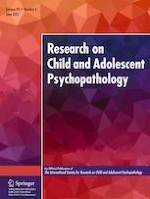03-02-2021
Developmental Variation in the Associations of Attention Bias to Emotion with Internalizing and Externalizing Psychopathology
Gepubliceerd in: Research on Child and Adolescent Psychopathology | Uitgave 6/2021
Log in om toegang te krijgenAbstract
Attention biases to emotion are associated with symptoms of internalizing and externalizing psychopathology in children and adolescents. It is unknown whether attention biases to emotion and their associations with different symptoms of psychopathology vary across development from early childhood through young adulthood. We examine this age-related variation in the current study. Participants (N = 190; ages: 4–25) completed survey-based psychopathology symptom measures and a dot-probe task to assess attention bias to happy, sad, and angry relative to neutral faces. We tested whether linear or non-linear (e.g., spline-based models) associations best characterized age-related variation in attention to emotion. We additionally examined whether attention biases were associated with depression, anxiety, and externalizing symptoms and whether these associations varied by age. No age-related differences in attention biases were found for any of the emotional faces. Attention biases were associated with psychopathology symptoms, but only when examining moderation by age. Biased attention to angry faces was associated with greater symptoms of anxiety and depression in adolescents and young adults, but not children. Similarly, biased attention to happy faces was associated with externalizing symptoms in adolescents and young adults, but not in children. In contrast, biased attention to happy faces was associated with greater anxiety symptoms in children, but not in adolescents or young adults. Biased attention toward social threat and reward becomes more strongly coupled with internalizing and externalizing symptoms, respectively, during the transition to adolescence. These findings could inform when interventions such as attention bias modification training may be most effective.
